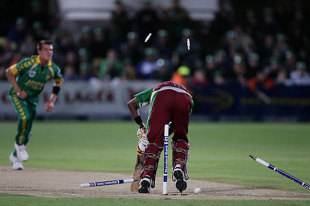Four stumps and first-ball free hits for Twenty20
An Australian Cricketers' Association survey conducted on the future of Twenty20 has raised some interesting suggestions for the shorter format of the game
Cricinfo staff
19-Dec-2007
|
|

|
An Australian Cricketers' Association (ACA) survey conducted on the future of Twenty20 has raised some interesting suggestions for the shorter format of the game, reports the Sydney Morning Herald. The ideas included using four stumps instead of three and giving a free hit from the first ball a batsman faced.
The other innovations the domestic and international players developed were an extra over for bowlers who took a wicket and no leg-byes. A return to the Supersub and technological ideas, including hand-held television screens for umpires to allow them to make faster run-out decisions, were also proposed.
"Whilst a lot of players are traditionalists, they are moving down a path of wanting to bring more people to the game," Paul Marsh, the ACA chief executive, said. "What's really important is that whatever innovations are brought in, they don't affect the integrity of the game on the field."
In what could be a major move, 41% of Cricket Australia-contracted players expressed their support for wearing shorts during Twenty20 matches, while 82% favoured changing uniform colours. Only 6% felt playing live music during the game would affect their performance.
Players were much less excited on the issue of using nicknames on t-shirts - as in the recent Twenty20 international between Australia and New Zealand - and of celebrity players for one-off appearances. The rugby league player Andrew Johns turned out for New South Wales earlier this year.
International players had no problems with the use of on-field microphones and in-game interviews. Adam Gilchrist and Andrew Symonds were tagged during the game against New Zealand and 94% were in favour of using microphones while 88% had no issues with batsmen being interviewed right after their dismissal.